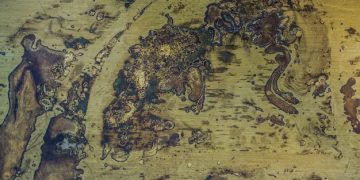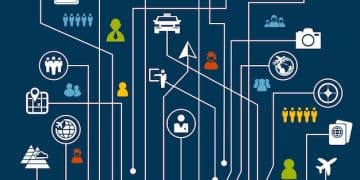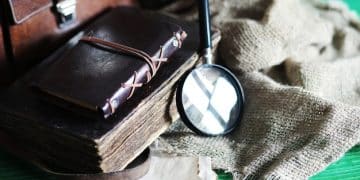Unlock Truth: Using Primary Sources to Verify News
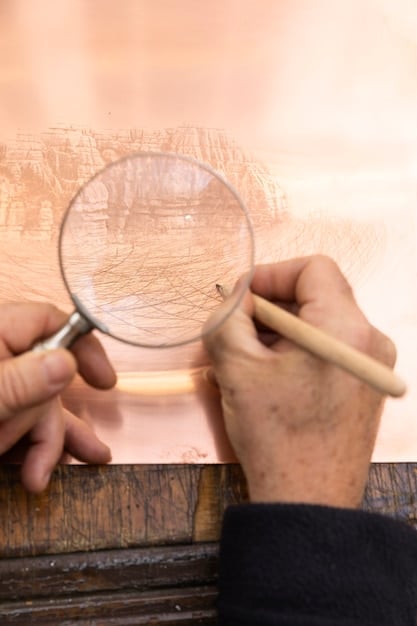
The Power of Primary Sources: How to Use Original Documents to Verify News and Information lies in its ability to provide direct, firsthand evidence, offering a more reliable way to assess the accuracy and credibility of news stories and other forms of information we encounter daily.
In an era saturated with information, discerning truth from falsehood is more crucial than ever. The Power of Primary Sources: How to Use Original Documents to Verify News and Information becomes an essential skill for navigating the complexities of modern media.
Understanding primary sources
Primary sources offer a direct window into the past and present. They stand as original materials created during the time under investigation or by individuals with firsthand experience of an event. This provides an unfiltered view, making them invaluable for verifying information.
What Qualifies as a Primary Source?
Defining a primary source involves understanding its origin and purpose. Typically, these are documents or artifacts that offer direct evidence concerning an event, object, person, or work of art. The key is the immediacy of the source to the event.
Examples range widely, encompassing diaries, letters, photographs, and even raw statistical data. Each type provides distinct insights depending on the nature of inquiry.
- Personal Diaries: Offer intimate perspectives on daily life and significant events.
- Official Documents: Include legal records, government reports, and treaties.
- Photographs and Audio Recordings: Capture moments in time, providing visual and auditory evidence.
- Data Sets: Contain raw numbers that can be analyzed to reveal trends and patterns.
The use of primary sources enriches research by providing depth and authenticity, allowing for a more nuanced interpretation of historical or current events.
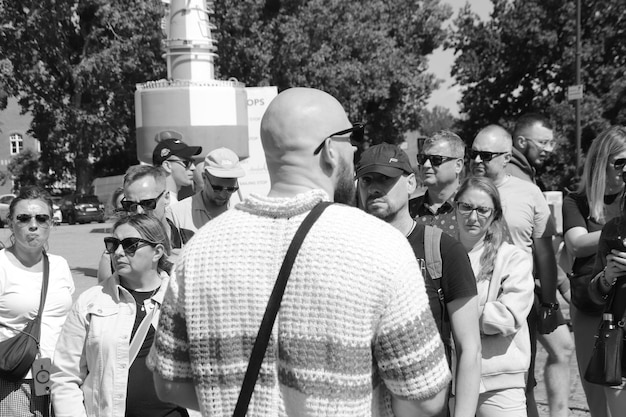
Primary sources are not just relics of the past. They continue to be created, forming the foundation of our understanding of current events. By engaging with these original materials, we equip ourselves with tools for critical evaluation.
Why primary sources matter in news verification
In today’s fast-paced news cycle, misinformation spreads rapidly. Primary sources provide a vital layer of defense against false narratives, allowing individuals to assess the evidence directly.
Combating Misinformation
With the rise of fake news, relying on secondary interpretations can be risky. Primary sources offer an alternative by providing direct access to original information, unfiltered by journalistic or editorial bias.
By verifying claims against original documents or data, we reduce the chances of being misled. This approach promotes a more informed and skeptical consumption of news.
Consider a news report about climate change. Instead of accepting the reporter’s interpretation of a scientific study, looking at the raw data from the study itself gives you an unbiased perspective. This direct examination empowers you to form your own educated opinions, reducing dependence on potentially skewed media narratives.
- Direct Evidence: Primary sources offer unfiltered evidence.
- Bias Reduction: They minimize the risk of interpretive bias.
- Informed Opinions: Enables the formation of educated opinions.
- Fact-Checking: Essential resources for validating reports and statistics.
Primary sources are necessary tools for anyone committed to uncovering the truth behind news stories.
Locating primary sources
Accessing primary sources has become easier than ever thanks to digital archives and online databases. These resources offer a wealth of original materials that can be explored from anywhere in the world.
Online Archives and Databases
Major institutions like the Library of Congress and the National Archives offer extensive digital collections. These include digitized documents, photographs, and audio recordings that are freely accessible online.
Academic databases, such as JSTOR and ProQuest, also provide access to scholarly articles that often feature primary source material. These databases require subscriptions, but can often be accessed through university libraries.
For instance, a researcher investigating the civil rights movement might access digitized copies of letters from activists or recordings of speeches given during protests. These materials provide firsthand accounts that enrich the understanding of this pivotal period in history. By leveraging these resources, researchers and the public alike can engage directly with the past.
- Library of Congress: Offers a vast collection of digitized historical documents.
- National Archives: Provides access to federal records and historical materials.
- JSTOR and ProQuest: Academic databases with access to scholarly articles and primary sources.
By mastering the use of these resources, one can significantly enhance their ability to verify information and uncover historical truths.
How to analyze primary sources
Analyzing primary sources requires a different approach than reading secondary accounts. It’s essential to consider the context in which the source was created and the potential biases of its author.
Critical Evaluation Techniques
Start by identifying the author and their background. Understanding their position and motivations can provide valuable context for interpreting their work. Next, examine the document itself, noting its purpose, intended audience, and any inherent biases.
Compare the information presented in the primary source with other accounts of the same event. Look for corroboration or contradiction, and consider the reasons for any discrepancies.
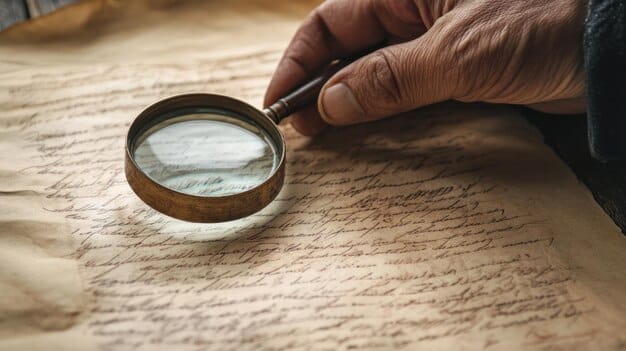
For instance, when analyzing a political speech, consider the speaker’s political affiliation and the context in which the speech was given. Understanding these factors can help you interpret the speaker’s message and assess its credibility.
Analyzing primary sources requires attention to detail and a willingness to question assumptions. By mastering these techniques, one can extract valuable insights and form well-informed opinions.
Examples of news verification using primary sources
Real-world examples illustrate the power of primary sources to challenge narratives and uncover the truth. These instances demonstrate how individuals and organizations have successfully used original documents to verify news stories.
Case Studies
One notable case involves the debunking of a widely circulated claim about a historical event. By examining original letters and diaries from individuals who lived through the event, researchers were able to reveal inconsistencies in the popular narrative.
Another example involves the verification of statistical data presented in a news report. By accessing the raw data sets from the original source, analysts were able to identify errors in the reporter’s calculations and correct the record.
By examining these cases, we can learn valuable lessons about the importance of primary sources in ensuring the accuracy and integrity of news reporting.
- Historical Claims: Cross-referencing with personal letters and diaries.
- Statistical Reporting: Validating claims through raw data sets.
- Event Narratives: Comparing official documents with eyewitness accounts.
Primary sources serve as powerful tools for holding journalists and news organizations accountable.
Challenges and limitations
While primary sources are invaluable, they are not without their challenges and limitations. Accessing and interpreting these materials can be difficult, requiring specialized skills and resources.
Potential Pitfalls
One challenge is the accessibility of primary sources. Many original documents are housed in archives or private collections, making them difficult to locate and access. Even when sources are available online, they may be behind paywalls or require specialized software to view.
Another challenge is the potential for bias in primary sources. Authors may have their own agendas or perspectives that influence their accounts. It’s essential to consider these biases when interpreting the material.
For instance, a diary entry from a soldier during wartime may provide a vivid account of their experiences, but it’s important to remember that the soldier’s perspective may be limited and influenced by their own beliefs and emotions. By acknowledging these challenges, we can approach primary sources with a critical and nuanced perspective.
Despite these challenges, the benefits of using primary sources far outweigh the risks. By understanding their limitations, we can use them effectively to verify information and uncover historical truths.
| Key Point | Brief Description |
|---|---|
| 🔍 Understanding Primary Sources | Original materials offering direct evidence about an event, person, or period. |
| 📰 News Verification | Primary sources combat misinformation by providing unfiltered, verifiable information. |
| 🌐 Locating Sources | Online archives like the Library of Congress offer extensive digital collections. |
| 🧐 Analyzing Sources | Evaluate author’s background and compare information with other accounts. |
Frequently Asked Questions
▼
Primary sources are original materials from the time period or event being studied. They offer firsthand accounts or direct evidence, such as letters, diaries, photographs, or official documents.
▼
Reliable primary sources can be found in digital archives like the Library of Congress, National Archives, and academic databases like JSTOR. University libraries also provide access to such materials.
▼
Analyze primary sources by considering the author’s background and context, examining the source’s purpose, and comparing the information with other accounts to identify potential biases or discrepancies.
▼
Limitations include accessibility—some sources are difficult to locate or behind paywalls. Also, sources can contain bias, as authors may have agendas influencing their reporting or recollections of events.
▼
Primary sources combat misinformation by offering direct, unfiltered evidence that helps verify claims and challenge false narratives, promoting a more informed and skeptical consumption of news.
Conclusion
In conclusion, the power of primary sources: how to use original documents to verify news and information is a skill that empowers individuals to seek truth and make informed decisions in a world filled with misinformation. By accessing, analyzing, and understanding these original materials, we can all become more critical consumers of news and more informed citizens.

